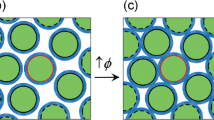Summary
The interfacial polarization of spherical dispersions is dealt with theoretically, and is discussed for the actual cases of emulsions.
First it is shown that theMaxwell theory is not valid qualitatively for the dielectric properties of emulsions. Next the general solution of theWagner theory is derived. This solution shows that a dielectric dispersion due to the interfacial polarization is characterized by a single relaxation time. It is found that theWagner theory is not valid quantitatively for the actual emulsions.
Finally a new theory of the interfacial polarization is developed on the assumption that theWagner equation holds for an infinitesimally increasing process in concentration of the dispersion system. Several dielectric properties of emulsions are interpreted quantitatively by this new theory. Dielectric dispersions due to the interfacial polarization have so far been observed only in the W/O emulsions, and no example of the interfacial polarization has been found in usual emulsions of the O/W type yet. According to the new theory it is suggested that, if the dielectric constant of the oil phase is much larger, the dielectric dispersion due to the interfacial polarization may be observed even in emulsions of the O/W type.
Zusammenfassung
Die Grenzflächenpolarisation kugeliger Dispersionen wird theoretisch behandelt und an Fällen von Emulsionen diskutiert.
Zuerst wird gezeigt, daß dieMaxwellsche Theorie für die dielektrischen Eigenschaften von Emulsionen nicht einmal qualitativ gilt. Als nächstes wird eine allgemeinere Lösung derWagner- Theorie abgeleitet. Diese zeigt, daß eine dielektrische Dispersion einer Grenzflächenpolarisation, durch eine einzelne Relaxationszeit charakterisiert, zuzuschreiben ist. Auch dieWagnersche Theorie gilt für wirkliche Emulsionen nicht quantitativ.
Schließlich wird eine neue Theorie der Grenzflächenpolarisation auf der Basis entwickelt, daß dieWagner-sche Gleichung für ein infinitesimales Anwachsen der Konzentrationen von dispersen Systemen gilt. Zahlreiche dielektrische Eigenschaften von Emulsionen sind mit dieser neuen Theorie quantitativ interpretierbar.
Dielektrische Dispersion durch Grenzflächenpolarisation wurde bisher nur in W/O-Emulsionen beobachtet, und kein Beispiel von Grenzflächenpolarisation ließ sich in gebräuchlichen Emulsionen des O/W-Typs bis heute auffinden. Nach der neuen Theorie wird vermutet, daß die dielektrische Dispersion auf Grund von Grenzflächenpolarisation auch in Emulsionen des O/W-Typs beobachtet werden könnte, falls die Dielektrizitätskonstante der Ölphase viel größer wäre.
Similar content being viewed by others
References
Fricke, H. andH. J. Curtis, J. Phys. Chem.41, 729 (1937).
Maxwell, J. C., Electricity and Magnetism Vol. I, p. 452 (London 1892); vonHippel, A. R., Dielectrics and Waves, p. 228 (New York 1954).
Wagner, K. W., Arch. Electrotechn.2, 371 (1914).
Fricke, H., J. Phys. Chem.57, 934 (1953).
Sillars, R. W., J. Inst. Elec. Engrs. (London)80, 378 (1937).
Hamon, B. V., Aust. J. Phys.6, 304 (1953).
Kharadly, M. M. Z. andW. Jackson, Proc. Inst. Elec. Engrs. (London)100 (III), 199 (1953).
Dryden, J. S. andR. J. Meakins, Proc. Phys. Soc.70B, 427 (1957).
Hanai, T., N. Koizumi andR. Gotoh, Kolloid-Z.167, 41 (1959).
Hanai, T., N. Koizumi, T. Sugano andR. Gotoh, Kolloid-Z.171, 20 (1960).
Bruggeman, D. A. G., Ann. Physik24, 636 (1935).
Becher, P., Emulsions, p. 327 (New York 1957).
Wiener, O., Abh. Math. Phys. kgl. Sächs. Ges. Wiss.32, 509 (1912).
Fricke, H., Phys. Rev.24, 575 (1924).
See, for example,Titchmarsh, E. C., The Theory of Functions Chap. II (London 1932).
Rue, R. E. D. L. andC. W. Tobias, J. Elektrochem. Soc.106, 827 (1959).
Author information
Authors and Affiliations
Rights and permissions
About this article
Cite this article
Hanai, T. Theory of the dielectric dispersion due to the interfacial polarization and its application to emulsions. Kolloid-Zeitschrift 171, 23–31 (1960). https://doi.org/10.1007/BF01520320
Received:
Issue Date:
DOI: https://doi.org/10.1007/BF01520320




